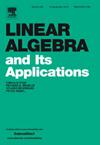On the incidence matrix of a graph with matrix weights
IF 1.1
3区 数学
Q1 MATHEMATICS
引用次数: 0
Abstract
Let G be a simple, oriented, edge weighted graph with n vertices and m edges, where weights are matrices in (the set of all square matrices of order s). It is well-known that if G is connected and weights are nonzero scalars, then the rank of the vertex-edge incidence matrix is . We observe that if the weights are rank k matrices in , then . In particular, when (i.e., weights as rank one matrices) and , then . We show that for large values of s, there exist assignments of rank one weights from such that all integer values between and m can be attained as the rank of . Further, we study the smallest possible values of s for which these ranks can be attained. Surprisingly, the smallest value of s for which m can be achieved as need not be . Even more interestingly, it turns out that the minimum value of s is the arboricity of the graph, i.e., the least number of colors needed to color the edges of G so that no cycle is monochromatic. As an extension, we supply an expression of the minimum values of s for which the intermediate values for the ranks of can be achieved. For a graph G, can give more information on G if we consider matrix weights. We show that a connected graph G on n vertices is a tree if and only if for every assignment of rank one weights from , . Such characterization is not available when we consider nonzero scalar weights. We also establish a characterization for unicyclic graphs based on the rank of the incidence matrix. Moreover, we discuss briefly the Laplacian matrices of graphs with matrix weights in view of the results obtained in this paper.
关于具有矩阵权值的图的关联矩阵
设G是一个简单的、有方向的、有n个顶点和m条边的边加权图,其中权值是Ms单位的矩阵(所有s阶方阵的集合)。众所周知,如果G是连通的,且权值是非零标量,则点边关联矩阵Q(G)的秩为n−1。我们观察到,如果权重是Ms中的秩k矩阵,则(n−1)k≤rankQ(G)≤min (n−1)s,mk}。特别地,当k=1(即权重为秩一矩阵)且s≥mn−1时,则n−1≤rankQ(G)≤m。我们证明了对于较大的s值,存在从m开始的第1阶权赋值,使得所有介于n−1和m之间的整数值都可以作为Q(G)的秩。进一步,我们研究了s的最小可能值,使这些秩可以得到。令人惊讶的是,使m可以达到rankQ(G)的s的最小值不必是≤≤mn−1≤。更有趣的是,s的最小值是图的任意性,也就是说,为G的边缘上色所需的最少颜色数,这样就没有一个循环是单色的。作为推广,我们给出了s的最小值表达式,其中Q(G)的秩的中间值可以得到。对于图G,如果我们考虑矩阵权值,rankQ(G)可以给出更多关于G的信息。我们证明了n个顶点上的连通图G是树,当且仅当从M2分配第1阶的权值时,rankQ(G)=n−1。当我们考虑非零标量权重时,这种表征是不可用的。我们还建立了基于关联矩阵秩的单环图的表征。此外,结合本文的研究结果,我们还简要地讨论了具有矩阵权值的图的拉普拉斯矩阵。
本文章由计算机程序翻译,如有差异,请以英文原文为准。
求助全文
约1分钟内获得全文
求助全文
来源期刊
CiteScore
2.20
自引率
9.10%
发文量
333
审稿时长
13.8 months
期刊介绍:
Linear Algebra and its Applications publishes articles that contribute new information or new insights to matrix theory and finite dimensional linear algebra in their algebraic, arithmetic, combinatorial, geometric, or numerical aspects. It also publishes articles that give significant applications of matrix theory or linear algebra to other branches of mathematics and to other sciences. Articles that provide new information or perspectives on the historical development of matrix theory and linear algebra are also welcome. Expository articles which can serve as an introduction to a subject for workers in related areas and which bring one to the frontiers of research are encouraged. Reviews of books are published occasionally as are conference reports that provide an historical record of major meetings on matrix theory and linear algebra.

 求助内容:
求助内容: 应助结果提醒方式:
应助结果提醒方式:


